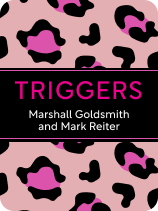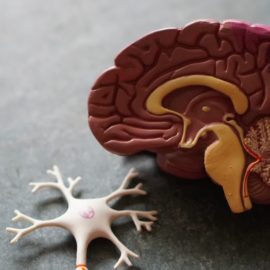

This article is an excerpt from the Shortform book guide to "Triggers" by Marshall Goldsmith and Mark Reiter. Shortform has the world's best summaries and analyses of books you should be reading.
Like this article? Sign up for a free trial here.
What is Marshall Goldsmith and Mark Reiter’s book Triggers about? What’s the key message to take away from the book?
In their book Triggers, executive coach Marshall Goldsmith and co-author Mark Reiter examine how triggers derail our efforts to behave in our best interests. They explain how you can become aware of your triggers, define the goals that will best serve you, and do the hard work of changing your behavior.
Below is a brief overview of Triggers by Marshall Goldsmith and Mark Reiter.
Triggers: Creating Behavior That Lasts–Becoming the Person You Want to Be
We have a hard time changing our behavior, especially in interactions with other people. We often encounter situations the writers call “triggers” that can sabotage even our best efforts at behaving more positively and productively in our relationships with others. For example, a trigger like an interruption to your work might make you speak curtly to your colleagues for the rest of the afternoon. Or a disagreement with a friend might put you in a bad mood that colors how you talk to your spouse when you get home.
In their book Triggers, published in 2015, executive coach Marshall Goldsmith and co-author Mark Reiter assert that you don’t have to let these triggers control you. Instead, by understanding how you’re affected by your environment and how you naturally react to it, you can change your behavior and become the more understanding spouse, calmer parent, more patient colleague, or more engaged friend you’d like to be.
Goldsmith and Reiter have collaborated on books such as The Earned Life (2022), What Got You Here Won’t Get You There (2007), and Mojo (2010). Goldsmith has worked with more than 200 CEOs in his career as an executive coach, and the lessons he shares often come from his observations of how even highly successful people struggle to change their interpersonal behavior.
Why Triggers Are Problematic
Our environment (and our reactions to it) shape our actions. We encounter environmental triggers everywhere, and even when they’re minor or short-lived, these incidents and situations bait us into acting in ways we know we shouldn’t.
Triggers can cause us to lose sight of the goals we’ve set for ourselves. When reacting to triggers, we might compromise on our plans, behave in ways that harm us or those around us, and generally fail to live up to our standards for the kind of person we’d like to be.
In this section, we’ll look at how the authors define triggers, examine how these stimuli affect our behavior, and explain how to spot them in your own life.
What Are Triggers?
Goldsmith and Reiter define a behavioral trigger as any stimulus you might encounter during your day and react to in that moment, such as a traffic jam, a string of notifications on your phone, or a demanding colleague.
A trigger can be positive or negative. Some triggers are pleasant to experience, and some are unpleasant. Similarly, some push us toward our goals while others pull us away from them. It’s how we respond to a trigger that determines its effect. Any stimulus in your environment can prompt you to behave in ways you’ll later regret.
For example, spending your lunch hour with a chronically pessimistic friend might trigger you to shoot down your colleague’s new ideas without considering them, or getting stuck in traffic might trigger you to snap at your spouse when you get home.
How Do Triggers Affect Our Behavior?
When you encounter a trigger, you experience an automatic impulse to react in a specific way, and those automatic reactions can damage your relationships. For example, if you snap at your spouse for misplacing some important paperwork, their hurt feelings will last much longer than your frustration at searching for the form.
Goldsmith and Reiter report that many people overcome triggers in high-stakes situations—where we know what others expect of us—but react to triggers in low-stakes situations—where the consequences of falling short feel more abstract. For example, you might remain present and attentive when your partner wants to talk about moving to a different city—a major change for both of you—but zone out as the conversation turns to plans for the weekend. (In your defense, you’re hungry and thinking about dinner!)
What Types of Triggers Might You Encounter?
When you want to change how you behave toward others, you first need to identify the triggers that affect how you treat those people. You can think of the kinds of triggers you might encounter in two ways: by their nature or by their origin.
Types of Triggers
First, Goldsmith and Reiter explain that triggers can be helpful versus unhelpful and pleasant versus unpleasant in nature.
A helpful trigger pushes you toward your goals, while an unhelpful trigger pulls you away from your goals. Pleasant triggers feel rewarding, and unpleasant triggers feel punishing. For example, your spouse’s exasperated reminder about the errands you need to run is helpful but unpleasant. Conversely, the dopamine surge you get from browsing social media during your colleague’s presentation is pleasant but unhelpful—and hazardous because it makes it feel rewarding to take a step away from your goal.
Second, Goldsmith and Reiter explain that another way to understand triggers is to think of them as either environmental or internal in origin. Environmental triggers are external, like a person who brings out the worst in you. Internal triggers are thoughts that keep you from trying to change in the first place or else sabotage your efforts as soon as they’ve begun.
The authors provide many examples of internal beliefs and assumptions that trip us up. For example, we might feel overconfident about our ability to resist temptation. It’s common to indulge in inconsistency and think that it’s OK to give in to our triggers sometimes, as long as we don’t do it all the time. We also lack objectivity and want to take credit for our successes but blame others for our failures.
Falling Prey to Triggers
The authors argue that, in some ways, giving in to triggers is human nature. In this section, we’ll look at some of the primary reasons why we succumb to the temptation of triggers, even when we know better and want to avoid them and their effects on our behavior.
We Don’t Do What We Planned to Do
No matter how realistic we think we’re being, we’re often overambitious when setting goals. As a result, we make plans that our environment—or our response to it—quickly derails. And no matter how often we’ve seen it happen, we don’t see it coming. For example, you might resolve to stay calmer with your children as you wake up in a quiet house but find yourself yelling when the morning chaos reaches a fever pitch.
Goldsmith and Reiter contend that this happens because each of us is part planner and part doer. The planner decides to change our behavior. But the doer has to enact that change. Often, the connection between the two breaks down, and we make plans that completely discount how we’ve behaved in the past, like putting a task on our to-do list and thinking we’ll get it done even though it’s been on every to-do list we’ve made for the last week.
We React Negatively When We Could React Positively
Most of us tend to react in negative and unproductive ways to unexpected events, another reason that triggers throw us off track. It feels easy and natural to respond this way when you encounter an unexpected provocation. It feels more challenging to take actions that make a positive and productive contribution to the situation.
This tendency may play a role in the behaviors that you’d like to change in your relationships, where you’d probably like to be a more positive person. For example, when a colleague annoys you, your partner asks you the same question for the 20th time, or your neighbor makes an obnoxious demand, making a cutting remark feels easier (and more rewarding) than being patient and empathetic.
We Have a Finite Capacity for Self-Regulation
Another reason we struggle with triggers is that we can practice only so much self-control in regulating our emotions and curbing our impulses. Goldsmith and Reiter explain that we gradually exhaust our capacity for self-regulation as we suppress our opinions, watch our behavior, and handle unexpected challenges. At each turn, we become more vulnerable to our triggers.
No matter how committed we feel to changing our behavior, we tend to make worse decisions after running down this gauntlet of tasks. That means we typically find it more difficult to be decisive or disciplined—and to avoid reacting to our triggers—at the end of the day.
The authors attribute this to a phenomenon called “ego depletion.” When we’ve used up our self-control, decisions become progressively more difficult to the point that we become reckless with them (or just decide to avoid them by sticking with the status quo).
We Don’t Push Ourselves Hard Enough Toward Our Goals
When we encounter a trigger, it can feel tempting to settle for “good enough” and let ourselves give in to our impulses. But we end up hurting or disappointing people when we decide that we can be on our best behavior later and go with “good enough” right now.
Goldsmith and Reiter use the term “satisficing” to describe how we’re often inclined to go with the good-enough option rather than put in the extra time, effort, or resources to get the best. But they note that we can’t (or shouldn’t) satisfice with our behavior toward other people.
The authors posit that we often satisfice in situations where we have marginal motivation, where we’re volunteering our time, where we consider ourselves amateurs, or where we want to opt out of other people’s rules. We might justify our actions to ourselves, but settling for good enough still means falling short of the goals we’ve set for ourselves.
Resisting Triggers
Understanding why we fall prey to triggers is the first step; the next step is actively resisting them. The writers argue that we can stop triggers from controlling our behavior. We’re not helpless against them. The authors offer many tools you can use to keep your environment from throwing you off course from the goals that you’ve set for yourself.
In this section of the guide, we’ve divided these strategies into two groups. The first group consists of plans or structures you can build ahead of time (or otherwise outside of the time when you’re in a triggering situation). The second group comprises strategies you can implement in the moment to stay focused on changing your behavior.
Before or Beyond the Triggering Situation
First, let’s look at some strategies that can help you get ahead of your triggers, either when you’re planning ahead and anticipating what your day might throw at you or when you’re recalibrating after a difficult day and trying to refocus on what matters most to you.
Ask for Help
The writers suggest that you ask the people around you to share their observations about the behavior you’re trying to change. You might not know why you’re acting in a way that’s inconsistent with your goals or values in a specific situation. And you might struggle to identify the trigger, like when you end up in a bad mood after a family dinner without realizing that your brother’s remarks about politics make you feel irritable.
Your family, friends, or colleagues can likely point out your triggers. Then, you can come up with a plan to change your reaction. Feedback from other people can also help you see how strongly the environment influences your behavior, which can motivate you to change.
Decide What to Keep and What to Change
Another way to get ahead of your triggers is to think about what you want to keep and what you want to change. Even in an area where you have room for improvement, you probably don’t need to change everything you’re doing. Instead, as you identify what you’re doing well and what you’d like to do better, you’ll find that you’ll want to build positive new behaviors (and continue existing ones) while stopping behaviors that don’t serve you. The writers note that that may even include realizing that some things are beyond your control and can’t be changed.
For example, if you want to connect with your partner, you could change your habit of going straight to the TV after dinner by sharing a cup of coffee instead. On the other hand, you could keep your habit of checking in with short texts throughout the day.
Test Yourself Every Day
Once you know what’s important to you and what you want to change, you can ask yourself a set of “daily questions” to track your progress. Goldsmith and Reiter explain that when you know you’re going to test yourself, you’ll feel more motivated to make productive choices during the day. In this way, the daily questions can help you stay engaged with the changes you want to make.
These are the steps involved:
1. Ask yourself, “Did I do my best?” about each important area of your life.
Each evening, measure your efforts toward your goals by asking whether you did your best to meet them. (This wording helps you reflect on effort, not performance.) Each question you ask yourself should assess a goal that’s important to you—a goal that, when you work toward achieving it, will help you become the person you want to be. For example, if you want to be a more engaged parent, you might ask yourself, “Did I do my best to give my child one-on-one attention today?”
2. Score your effort on a scale of 1 to 10.
Score your effort toward each goal on a scale from 1 to 10. Think about the actions you did or didn’t take. A score of 1 indicates minimal effort, while a score of 10 indicates maximum effort. You don’t necessarily have to have succeeded to earn a 10. You just need to have made a substantial and honest effort to work toward your goal.
You can even ask someone you trust to help you with this process. The writers recommend reporting your scores to someone else each day. Having someone to hold you accountable can give you more structure to push yourself to change.
3. Track your progress over time.
Track your answers to the daily questions over time. The daily questions have their utility in the moment. But if you collect your scores, patterns will likely emerge. For example, if you look at your data and see 9s and 10s for one goal but 1s and 2s for another, you can assess whether the latter goal really matters to you. If it does, you can change something to make a more substantial effort toward achieving it.
Think Ahead
To put yourself in the best position to resist your triggers before they happen, you can recognize ahead of time when a situation might trigger you. Goldsmith and Reiter clarify that when you know a particular environment is likely to influence you, you can choose not to engage with it. If you must spend time in that environment, you can alter your behavior to avoid reacting to the trigger.
For example, you might predict that a long conversation with a coworker who disagrees with everything you say might wear your patience thin. You might skip that conversation by taking an alternate route through the office. Or, you might change your behavior by not taking the bait.
In the Moment
Finally, let’s outline some strategies you can use as triggers arise to resist temptation, keep your behavior in check, and stay on track toward your most important goals.
Cultivate Awareness
Focus on cultivating awareness and practicing engagement. These are two tools that the authors assert will help you to notice the triggers in your environment and become more capable of responding to them in positive and productive ways. Think of a trigger as a catalyst: Normally, the catalyst sets off a chemical reaction. But you can add that moment of awareness as an inhibitor to stop the reaction.
We tend to think of many of our reactions as automatic, but they aren’t. If you train yourself to become aware of the impulse, then you can interrupt the progression from experiencing a trigger to reacting to that trigger. And when you engage, then you can choose how to act.
Remember to React Positively
You can’t become the person you want to be without learning to react in positive ways to unexpected triggers. It might help you just to remember this focus on positivity. Or, you can use structure to limit your options and attenuate your focus, which leads to better decisions that align with your long-term goals.
For those inclined to use a mantra, Goldsmith and Reiter recommend asking yourself: “Am I willing, at this time, to make the investment required to make a positive difference on this topic?” They shorten it to the acronym “AIWATT.”
Whether or not you use the acronym, you can focus on responding in positive and productive ways. Remind yourself of what you need to do in the present moment and consider whether the action you want to take would make the best use of your time, energy, and resources.
Compensate for Flagging Self-Discipline
When you know that a situation will test your ability to resist your triggers, you can add even more structure to keep your behavior in line. The writers recommend adapting the salient “daily questions” to check in with yourself more frequently during a challenging situation, as often as every hour. By continually restating your goal (and holding yourself accountable), you create a structure that helps you to practice self-discipline.Questioning yourself each hour of a demanding workday or a weekend with your in-laws can help you stay aware of your behavior. So even if you don’t score perfect 10s, you’ve still gained the advantage of awareness.

———End of Preview———
Like what you just read? Read the rest of the world's best book summary and analysis of Marshall Goldsmith and Mark Reiter's "Triggers" at Shortform.
Here's what you'll find in our full Triggers summary:
- What triggers are and how to recognize them
- Why triggers are so effective at affecting your behavior
- Tools and strategies for resisting and avoiding your triggers






